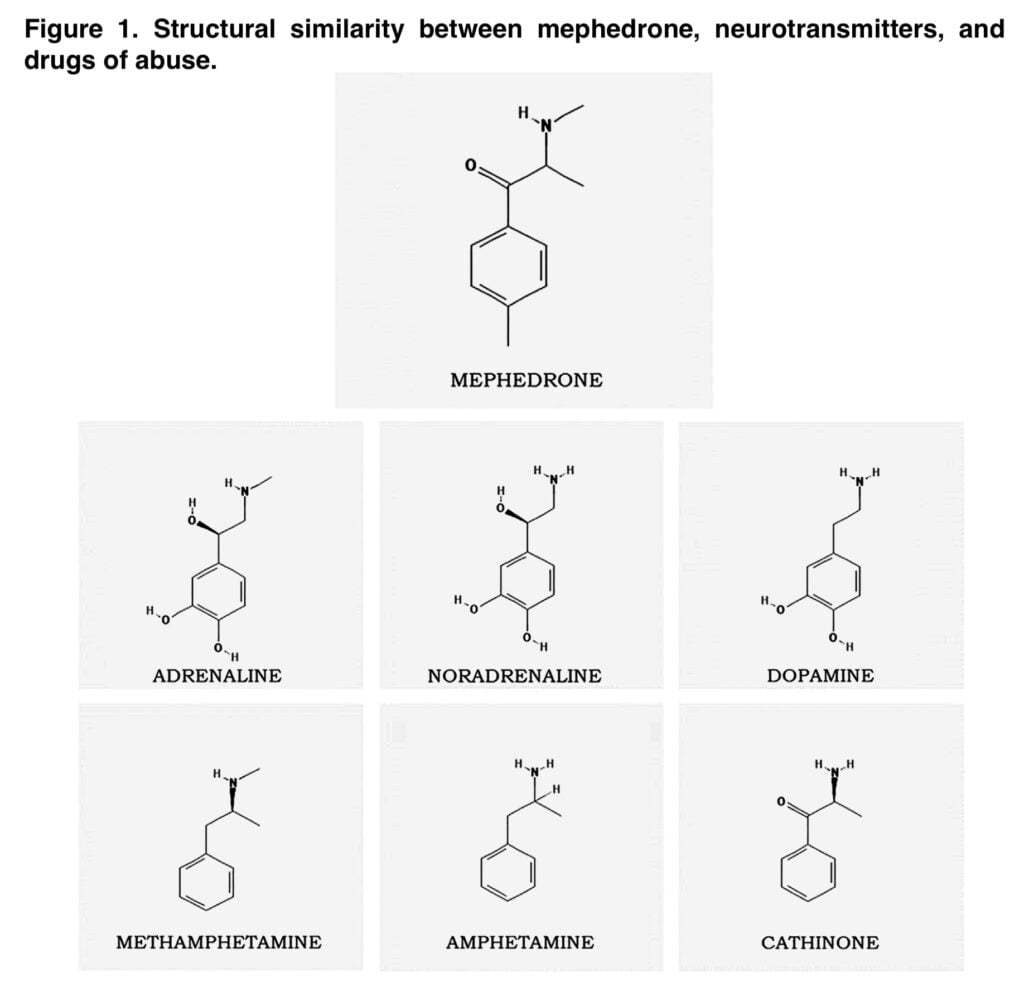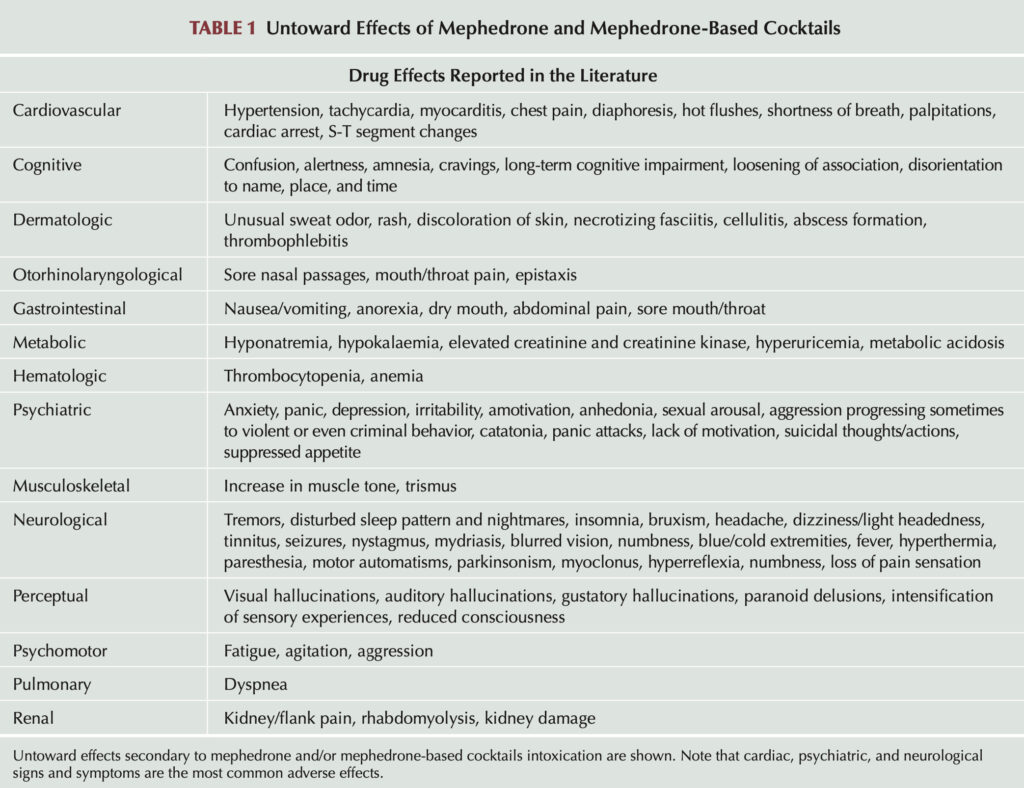Together with cathine, cathinone ((S)-2-amino-1-phenyl-1-propanone) is one of the active components of the shrub Catha edulis, which is grown in East Africa and the Arabian Peninsula. The plant’s leaves, often referred to as khat, qat, or chat, can be chewed or prepared as “tea” by brewing them. Both cathinone and cathine are scheduled substances under the UN 1971 Convention and both have stimulant effects comparable to those of synthetic stimulants like amphetamine, methamphetamine, or MDMA.
Methcathinone, which was permanently added to Schedule I of the Controlled Substances Act in October 1993, and mephedrone, which wasn’t used as a recreational drug until the early 2000s but has been growing in popularity very quickly since then, were both synthesized based on the cathinone structural formula in 1928 and 1929, respectively.

It is sold most as crystals or powder, but also in the form of capsules or pills to use by intranasal, oral and/or intravenous. Evidence available in humans shows that mephedrone produce acute cardiovascular, psychostimulant and empathogen effects, suggesting it could have a high abuse liability potential similarly to other substances with similar profile of action, as MDMA or methamphetamine. Acute management of mephedrone intoxication involves supportive care and symptomatic therapy. To date, there are no documented toxic effects after long-term exposure.
Mephedrone Cocktails: What Is It And Why Is It Important?
Today, mephedrone remains in recreational use worldwide, often consumed alongside traditional illicit substances such as methamphetamine and gamma-hydroxybutyrate (GHB), or legal drugs such as caffeine and alcohol. In rats, co-administration of caffeine with MDMA (3,4-methylenedioxymephampethamine), has been shown to potentiate the elevation of extracellular 5-HT brain levels, a neurochemical correlate of the serotonin syndrome. In humans, this syndrome is characterised by adverse physiological effects including fever, agitation and hypertension. Despite increased elucidation of its pharmacological profile since 2008, there remains a paucity of data on mephedrone’s behavioural and neurochemical effects.
MEPH produces physiological (e.g., increased arterial blood pressure, heart rate, pupil diameter, and body temperature) and subjective effects (e.g., stimulant-like results) typical of a psychostimulant drug, although with a faster onset and shorter duration when compared with 3,4-Methylenedioxymethamphetamine (MDMA). The metabolic disposition of MEPH in animal models is characterized by low bioavailability via the oral route and an extensive hepatic metabolism. Its metabolism has been described in rats, liver hepatocytes, human liver microsomes, and human biological samples.
MEPH is metabolized in the liver and the major metabolic reactions are N-demethylation, hydroxylation, oxidation, reduction, and conjugation with carboxylic acids and glucuronides. The cytochrome P450 2D6 (CYP2D6), a highly polymorphic drug metabolizing enzyme, has been described in vitro as the main enzyme responsible for the phase I metabolism of MEPH with some other contributions from NAPDH-dependent enzymes. CYP2D6 has been also implicated in the metabolism of other synthetic cathinones (such as methylone). The role of CYP2D6 polymorphism regarding MEPH disposition in humans, and its potential clinical relevance, has not yet been evaluated.

The emergence and popularity of mephedrone on the drug market occurred at the same time that online drug communities were growing rapidly. These developed into a point of reference for users, supplying knowledge about drug supply chains, offering guidance on how to use drugs most effectively, exchanging personal experiences regarding fashionable choices and harm reduction techniques, and ultimately contributing to the myth of “using illegal substances safely”.
If there were less than 10 internet drug sellers in March 2009, by June, as the drug’s popularity grew, new sites were popping up practically weekly, offering a variety of goods that claimed to contain mephedrone. Mephedrone rapidly became a matter of concern to public health because of its unwanted toxic and possibly lethal effects.
Users and internet
Mephedrone is believed by consumers to provide a more satisfying “high” than cocaine, therefore to frequent stimulant users, the “legal high” looked to be a more reliable, safe, and valuable product than its “traditional” counterpart. Accordingly with the well-known fact that youngsters are the most active Internet surfers, adolescents and young adults have become the largest segment with drug-related Internet activity. Mephedrone usage appears to be mostly a youth phenomena, including 15 to 24 year olds, particularly clubbers, who are interested in taking “legal drugs” according to research on the internet.
According to survey results, typical mephedrone users are young adult men (77%), with a mean age of 25.1 years old, who are working or enrolled in school (86%), and who have a history of stimulant use (96% ecstasy, 92% cocaine), as well as polydrug use. A major issue for users is the significant qualitative and quantitative variation in content of the available illegal products. Before the prohibition, Davies examined the actual ingredients of “legal highs” bought from five well-known UK websites.
Each supplier had at least one product during the six-month period taken into consideration that had content that varied significantly, thus neither the product name nor its ability to distinguish between single compounds and mixes corresponded necessarily to a specific drug. Additionally, the items weren’t consistently offered throughout time, thus exposing consumers to various active medicines with unpredictable effects. Last but not least, the cost per dosage was a poor indicator of the bought active ingredient.
Zuba and Byrska in Poland also pointed out the same inconsistency in the qualitative and quantitative composition of legal highs despite similar labeling, and it poses a severe and unanticipated hazard to users who have previously used the drug and presume the effects will be the same. In general, there are five different ways to buy mephedrone on the market: as a tablet, capsule, powder, liquid, or crystal, with the powder and crystalline forms being the most common. Mephedrone normally comes in the form of a racemic mixture of the stereoisomeric R and S forms of the hydrochloride salt, which can be white or colored.
Users describe the compound’s offensive stench as a blend of chloride, vanilla, and pee. It is often consumed in social settings such as friends’ homes, house parties, or night clubs. The bulk of the items the researchers looked at on the market had two or more substances in them, according to their analysis of their composition. Cathinones and piperazines were mixed mainly within the chemical classes (77.6% and 56.1% of dual links, respectively), caffeine was mixed both with piperazines (24 products) and cathinones (22 products), whereas lidocaine was mixed only with the latter class (47 products).
Only 55% of the 449 various “legal highs” that were examined included only one substance, such mephedrone. Mephedrone is often eaten in binge-style during a 9 hour period, with an average of six doses, each spaced 30 minutes to 2 hours apart. The total quantity taken each session can range from 25 mg to 9 g.

Desirable and unwanted effects of mephedrone
Increased sociability, vitality, and sexual arousal, the ability to work, a limited sense of pleasure, and other empathogenic effects are among the desired results cited by mephedrone users. Unsafe mephedrone concentrations are impossible to establish since they can be brought on by any effective dose, which is a significant problem. Additionally, different people may respond quite differently to the same dose.
The majority of the negative effects of mephedrone, shown in Table 1, resemble those of amphetamine, methamphetamine, and MDMA, according to previous research. The most frequent side effects among users of synthetic cathinones who needed medical attention include cardiac, mental, and neurological signs and symptoms. Hallucinations and psychosis may happen at very high dosages. People who have neurological, cardiac, or psychological issues may be more susceptible to adverse effects. Agitation was one of the most commonly described side effects after mephedrone use, followed by chest pain and paresthesia.
Some papers described also the paranoid psychotic delirium following the use of synthetic cathinones, such as mephedrone. These patients speak of having a life-threatening worry, believing that unidentified persons are spying on them, bothering them, breaking into their house, or want to kill them. The majority of reports of psychotic symptoms occurred with large doses, several dosages taken during one session, and in users who had a preexisting psychobiological susceptibility.
It has been documented that frequent use of high doses of mephedrone or mephedrone-related cocktails can lead to the onset of symptoms that meet the Diagnostic and Statistical Manual of Mental Disorders, Fourth Edition criteria for drug dependence, such as craving, tolerance, and withdrawal syndrome. The withdrawal syndrome, which is mainly seen after abruptly stopping long-term mephedrone usage, is characterized by sadness, anhedonia, anxiety, sleep problems, exhaustion. These signs and symptoms may last for several weeks.

The metabolic side effects are particularly significant among the undesirable consequences due to their rarity and intensity. Wong discussed a case of a type 1 diabetic guy who used mephedrone and afterwards experienced ketoacidosis. By activating the central nervous system, synthetic cathinone chemicals may directly raise the risk of diabetic ketoacidosis, and they may also indirectly make it more difficult for someone to control their diabetes by altering their behavior and cognitive processes.
Hyponatremia is another possible metabolic complication of mephedrone use; this is a well-reported complication of MDMA use too. It is thought to result from an increased 5-HT-mediated antidiuretic hormone secretion, with consequent decrease of sodium concentration in the blood. It is unclear if synthetic cathinones cause similar changes in sodium and water regulation. Three cases of hyponatremia associated with mephedrone exposure have been documented, suggesting that there could be some parallels. In the bodily fluid analyses of the three individuals, no MDMA was discovered. After consuming synthetic cathinones, AKI may occur for a variety of reasons.
These individuals’ acute renal vasospasm brought on by these vasoactive drugs likely caused tubular damage. Similar to cocaine, synthetic cathinones may encourage severe renal arteriolar vasospasm, causing renal hypoperfusion and renal ischemia as well as acute tubular necrosis. Additionally, they may cause nephrotoxic acute tubular necrosis by being directly toxic to tubular cells. Rhabdomyolysis, a side effect of mephedrone usage, may exacerbate kidney damage when combined with synthetic cathinone overdose.
The issues that can occur when bath salts containing mephedrone are injected intravenously or intramuscularly are really interesting. In these situations, soft tissue issues are typically brought on by contaminated substances, a lack of skin asepsis, sterile equipment, poor hygiene, and concomitant immunodeficiency condition. Risks associated with injections include the development of localized and widespread abscesses as well as localized discomfort, swelling, peripheral nerve palsies, cellulitis, and thrombophlebitis.
However, the most severe consequence is necrotizing fasciitis infection possibly leading to limb loss and/or death. In these cases deep muscular necrosis is often masked by a nonerythematous overlying tissue bed, and surgical intervention is often delayed after hospital admission.The case of a 19-year-old male who presented with a considerable ST elevation, elevated blood troponin concentration, and had an acute myocarditis after ingesting a gram of mephedrone-containing plant food was documented by Nicholson in terms of the cardiological consequences.
Signals from a cardiac magnetic resonance imaging (CMR) test were consistent with acute myocardial edema and inflammation. The direct toxicity of mephedrone on the myocyte or an immune-mediated process are the two potential mechanisms for how it causes myocardial inflammation.

Lethal complications of mephedroneand toxicological analysis
The syndrome of deadly excited delirium, which includes symptoms including agitation, delirium, acidosis, persistent heat, and autonomic dysfunction, is also described along with additional potentially fatal consequences. The symptoms of stimulant drug overdose are caused by excessive dopaminergic transmission, and they frequently lead to an abrupt stop of movement followed by cardiac and respiratory collapse.
With regard to the potentially lethal psychiatric effects the relationship pinpointed by some authors between consumption of mephedrone, or other synthetic cathinones, and risk of suicidal or homicidal behavior is remarkable. As reported in some cases, suicidal behavior is, in almost all cases, related to paranoid psychosis, and often is related to an attempt to escape from a perceived dangerous situation.
Numerous writers have published information about mephedrone users who become intoxicated. It is feasible to think of mephedrone dosages that result in acute, non-fatal intoxications needing hospitalization as falling between 0.1 and 7.0 g. Cosbey provided well-explained information derived from non-fatal intoxications.
The author emphasized the role of mephedrone and its cocktails in cases of driving impairment; they looked at the toxicological data of a group of 32 cases of impaired driving and highlighted the frequent use of mephedrone among drivers in Northern Ireland, likely as a result of its ability to increase attention while driving. Blood values in cases of impaired driving when mephedrone was the sole substance detected ranged from 0.08 to 0.66 mg/L.
Additionally, mephedrone blood values in patients who also tested positive for other drugs or alcohol ranged from 0.01 to 0.74 mg/L. These data are very interesting because drug levels have been associated with observed symptoms and results have not been complicated by possible postmortem redistribution effects, as can occur in postmortem cases. Redistribution is, in fact, a crucial factor to take into account when interpreting postmortem concentrations, particularly in situations where an endogenous generation of the drug is feasible, as in the case of GHB.
The first death incident involving the single use of mephedrone that was verified by toxicological testing was reported in Sweden in 2008. Mephedrone intoxication has now been linked to a number of fatalities, either when used alone or in conjunction with other substances. The toxicological results of solo mephedrone lethal intoxications have been the subject of several investigations.
The toxicological spectrum of deaths caused by mephedrone intoxication was only briefly described in a few publications. Blood postmortem values in these patients varied from 0.13 to 22 mg/L. Gerace have reviewed the lethal cases due to multidrug exposure and have reported their personal observation. In the cases reviewed, cocktails of mephedrone (0.5mg/L) and morphine (0.6mg/L); mephedrone (0.13mg/L) and methadone (0.3mg/L), diazepam, nordiazepam, olanzapine, and chlorpromazine metabolite; and mephedrone (0.5mg/L) and GHB (288mg/L) were described. In these cases, the medical examiner stated that the death was attributed to “multidrug intoxication”.

The same writers detailed their firsthand experience with a 25-year-old male who had used bath salts. Blood concentrations of 1.33, 130, and 0.018 mg/L for mephedrone, ethanol, and cocaethylene, respectively, were used to confirm the presence of each substance. Last but not least, Lusthof described the instance of a 36-year-old man who had seriously hurt himself by breaking windows while suffering from a deadly enthusiastic delirium. In this instance, the male ingested cocaine mixed with mephedrone (5.1mg/L). The presence of these values in the deceased’s blood indicates that mephedrone and cocaine were used or administered together.
Conclusion
In conclusion, further study is clearly needed to identify the adverse effects, provide methods to monitor symptom severity, and establish better treatment protocols as mephedrone becomes a more significant part of the drug community. Mephedrone can be combined with other synthetic cathinones, including the well-known mephedrone and MDPV combination, as well as mephedrone with other chemicals. The chemical makeup of this drug can vary greatly.
Mephedrone has a growing body of clinical evidence and information that is widely available online that shows it has a number of medically risky effects. As a result, its recreational use must be regarded as extremely risky to the public’s health, and at the very least, the most prevalent compounds made from combining mephedrone with other drugs should be subject to screening procedures in clinical and forensic toxicology.
